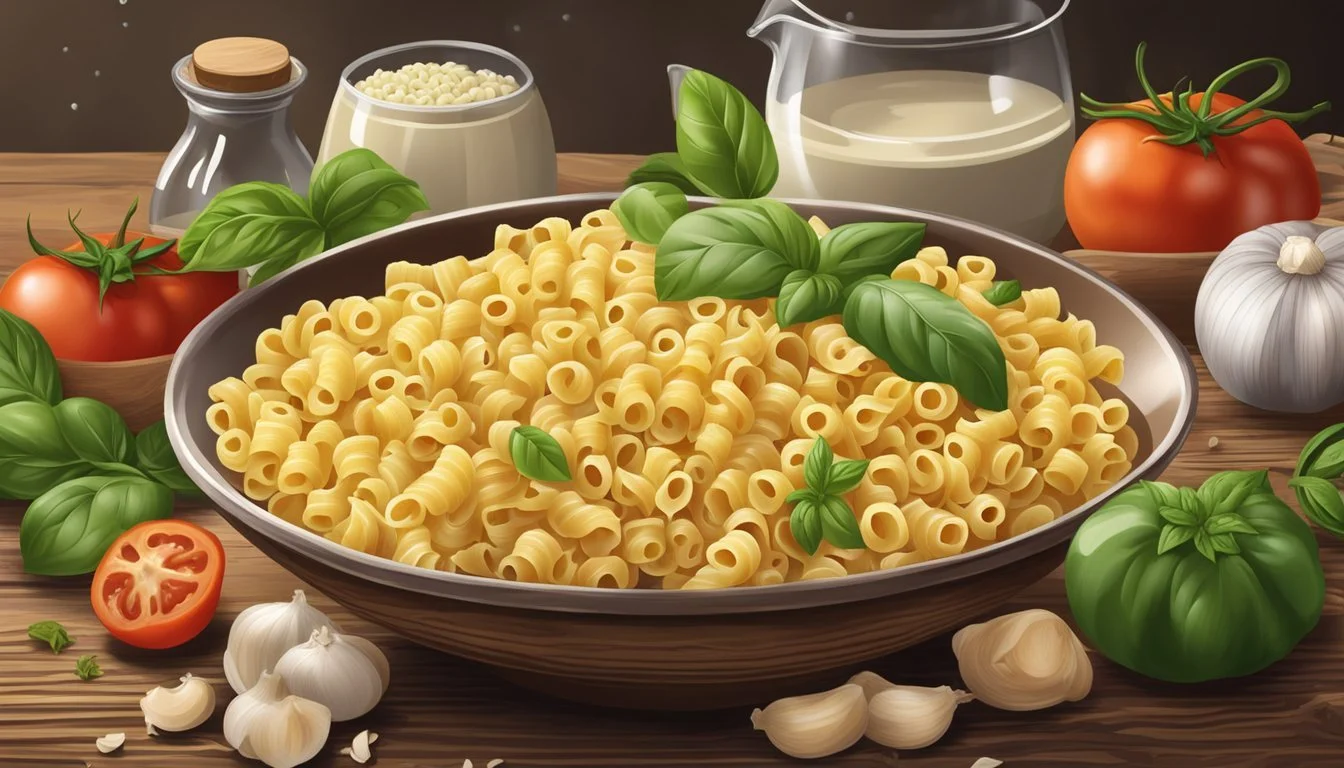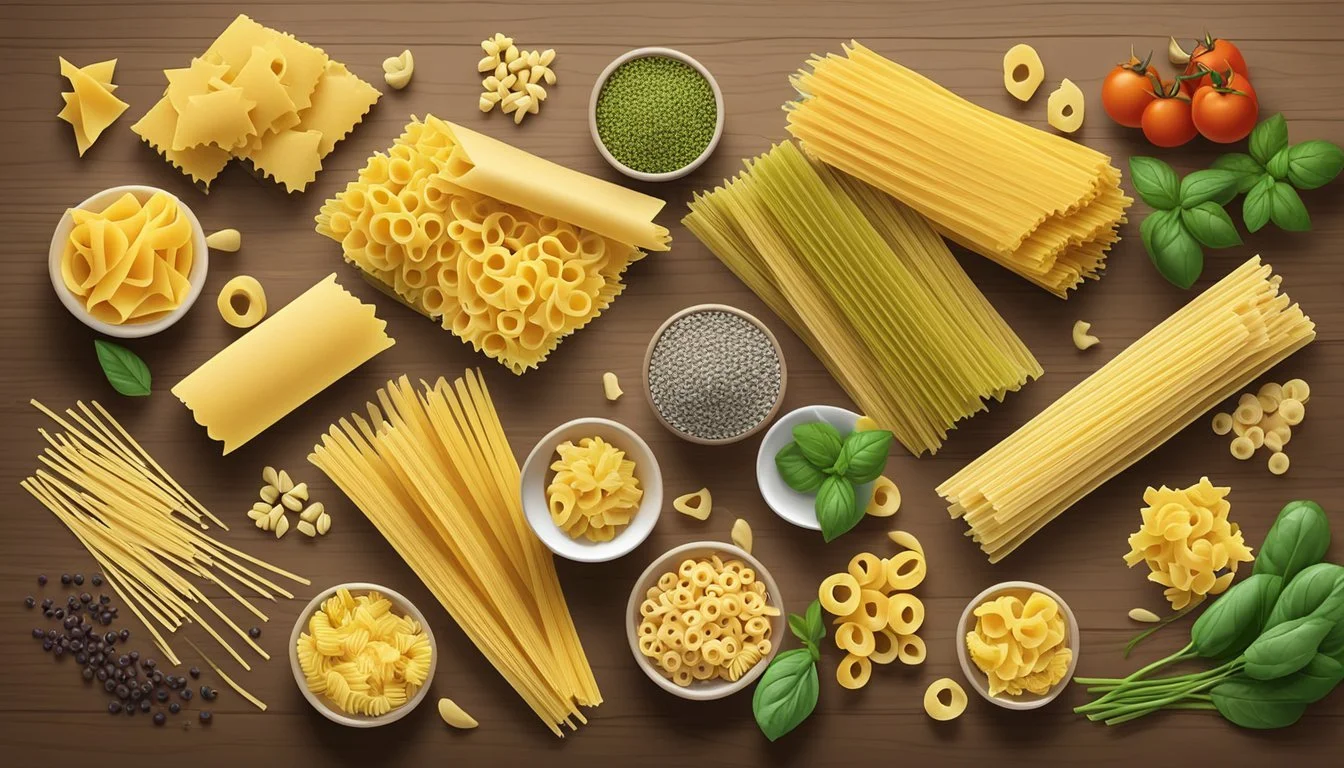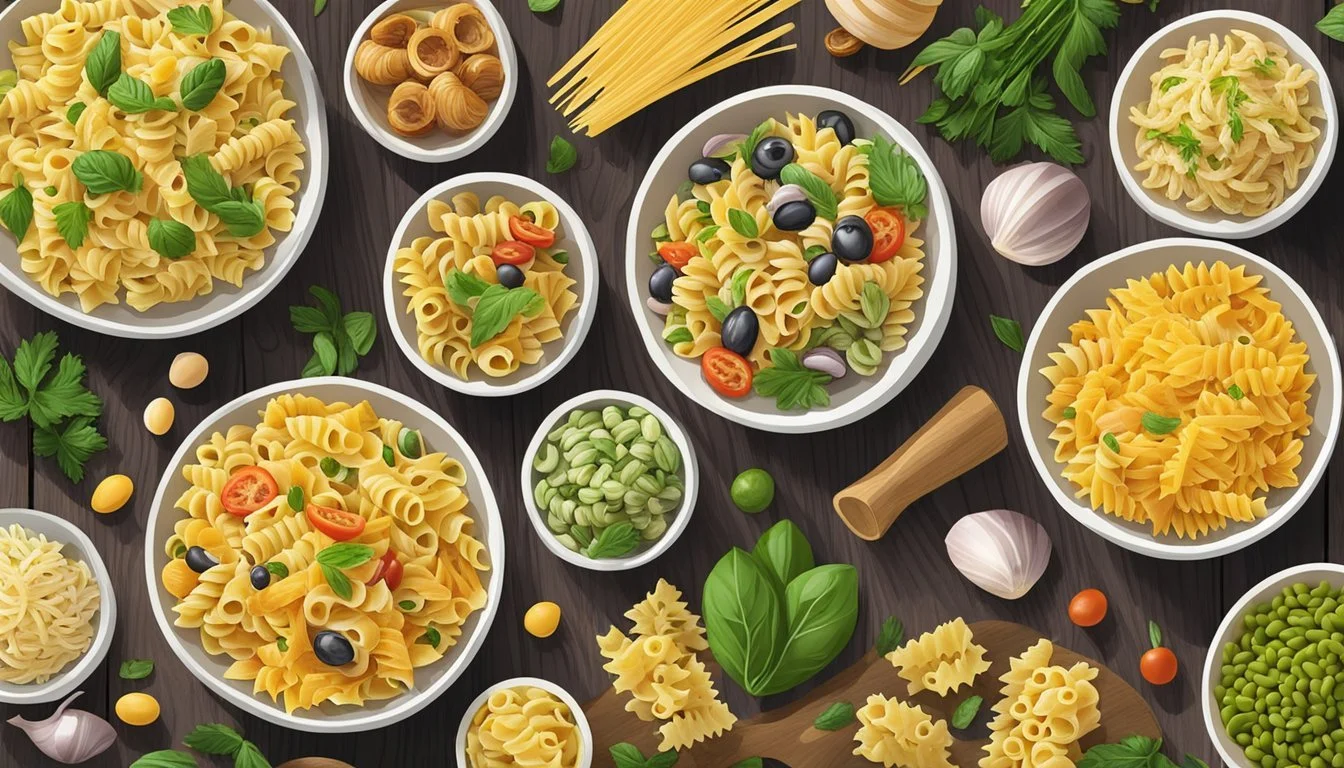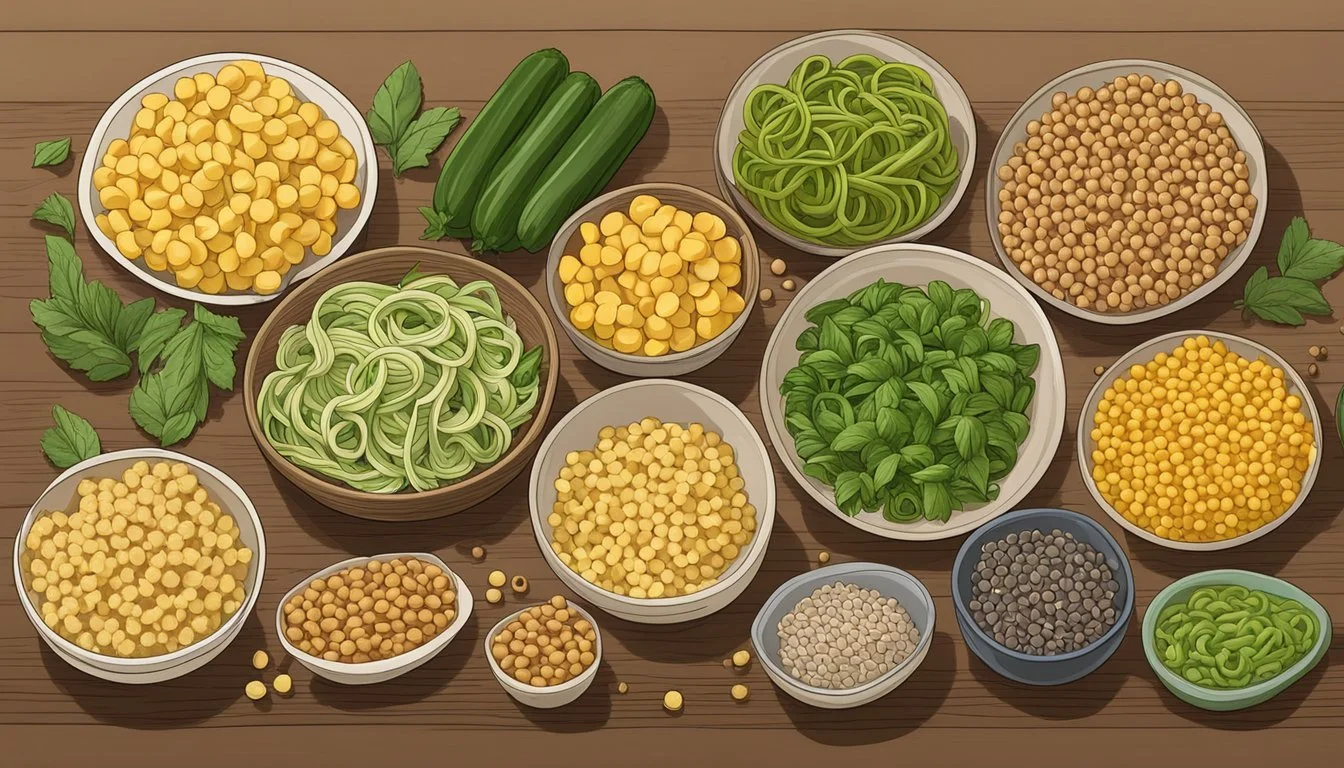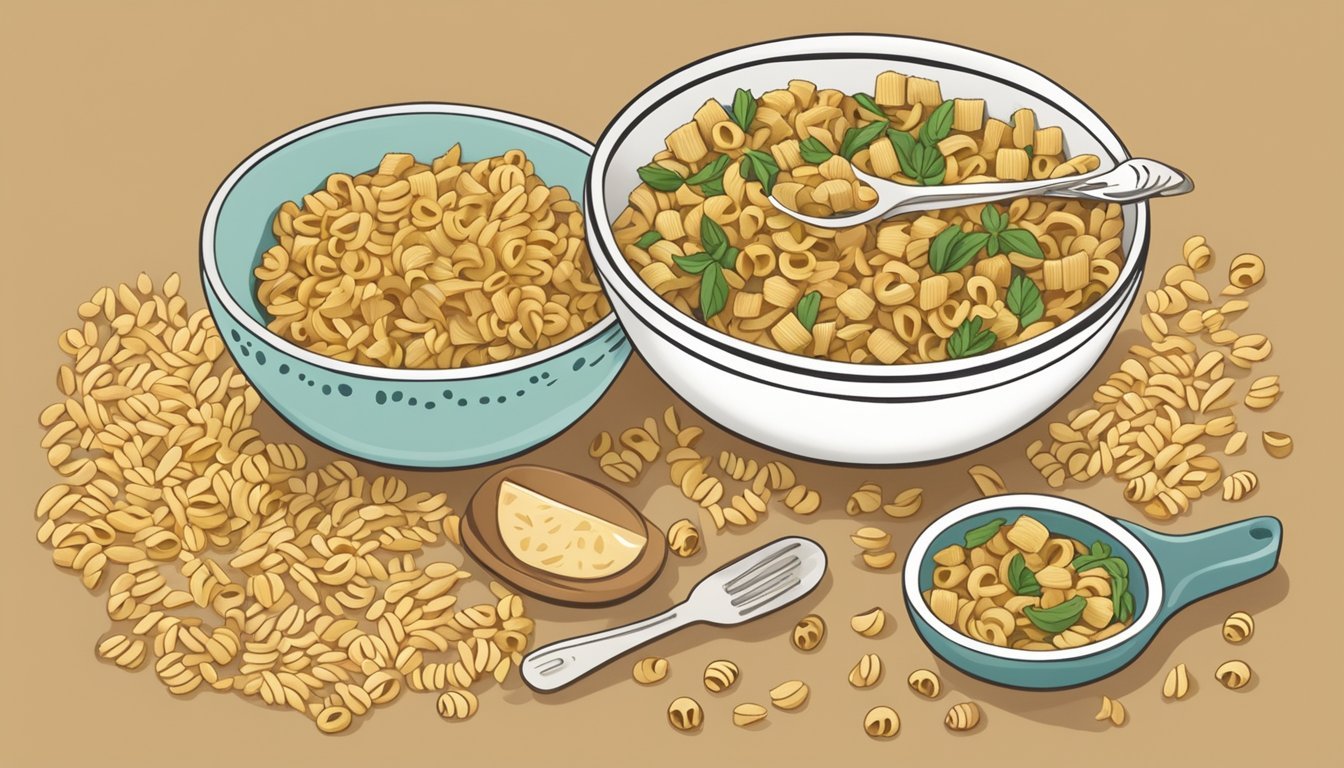Ditalini Pasta Substitutes
Top Alternatives for Your Recipe
Ditalini pasta, with its small tube shape, is a staple in many hearty soups (What wine goes well with soups?) and pasta (What wine goes well with pasta?) dishes. Its versatility and size make it an ideal choice for absorbing flavors and providing a satisfying bite. Despite its popularity, there are instances when cooks may need to find a substitute for ditalini pasta, whether due to dietary restrictions, personal preferences, or a simple lack of availability. Various pasta shapes can serve as suitable replacements without compromising the integrity of the recipes.
The search for ditalini pasta substitutes leads to a variety of small-sized pasta that can mimic the texture and cooking properties of the original. Pastas such as corallini and acini di pepe are similar in size and shape, making them excellent alternatives, especially in soups and broths. They both offer a delightful al dente texture while blending seamlessly into traditional Italian soffritto or similarly structured dishes.
In addition to these, other pastas like orzo and tubetti also stand out as practical substitutes. Orzo, with its rice-like appearance, adds a pleasant texture to soups and salads, while tubetti's tubular shape is akin to ditalini but slightly larger, applicable in a range of recipes from baked pasta dishes (What wine goes well with pasta dishes?) to rich stews (What wine goes well with stews?). These substitutes not only ensure that a dish retains its intended culinary experience but also cater to various preferences and dietary needs.
Understanding Ditalini Pasta
Before venturing into the world of pasta substitutes, it is important to grasp the essence of ditalini pasta. This small, tubular pasta holds a significant place in Italian cuisine, known for its distinct texture and ability to complement various dishes.
History and Origin
Ditalini pasta has its roots in Italian culinary traditions. The name translates to "little thimbles" in Italian, referring to its shape. It is made from semolina flour, a staple ingredient in Italian pasta craft. The exact origin within Italy is not pinpointed, but it is a beloved part of the nation's gastronomy.
Characteristic Texture and Flavor
The texture of ditalini pasta is firm, and when cooked al dente, it provides a satisfying bite. This is due to the high gluten content of semolina flour, which allows the pasta to maintain its shape and texture. The flavor of ditalini is typically mild and wheaty, making it an excellent absorber of the flavors in the dish it accompanies.
Typical Uses in Dishes
Ditalini pasta is incredibly versatile.
Soups: Its small size and substantial texture make it ideal for a variety of soups, from minestrone to pasta e fagioli, where it complements the broth without overpowering other ingredients.
Salads: Its ability to integrate well with dressings and vegetables makes it a common selection in pasta salads.
Casseroles (What wine goes well with casseroles?): Ditalini's shape allows it to meld with cheeses and sauces, contributing to a hearty casserole's texture and flavor profile.
Across these applications, ditalini pasta embodies the essence of Italian cuisine, providing a base that elevates the overall dish.
Selecting Ditalini Substitutes
When preparing a recipe calling for ditalini, selecting an appropriate pasta substitute involves evaluating options based on similarity in size, shape, and cooking properties.
Criteria for Choosing
Size and Shape: The substitute should match ditalini's small, tubular size to maintain the intended texture of the dish. Ideally, it should also have a hollow center capable of absorbing flavors from sauces or broths.
Cooking Time: Choose a pasta with a similar cooking time to ditalini to prevent overcooking when used in recipes like soups or salads.
Flavor Compatibility: The alternative should have a neutral flavor that does not overpower other ingredients in the dish.
Nutritional Profile: Consider the health benefits of the pasta substitute, especially if aiming for a higher fiber or whole grain option.
Top Substitute Options
Orzo:
Shape: Rice-like
Texture: Adds texture and bite
Cooking Time: Comparable to ditalini
Flavor: Neutral, blends well with various ingredients
Tubetti:
Shape: Small, tubular
Texture: Similar to ditalini
Cooking Time: Matches ditalini
Flavor: Neutral
Corallini:
Shape: Small, tubular with a smaller interior
Texture: Ideal for absorbing flavors in broths
Cooking Time: Quick cooking, suitable for soups
Flavor: Complements traditional Italian soffritto
Acini Di Pepe:
Shape: Small, spherical
Texture: Produces an al dente texture
Cooking Time: Short
Flavor: Mild nutty flavor
Ditaloni:
Shape: Larger version of ditalini
Texture: Works well in hearty dishes
Cooking Time: Longer due to size
Flavor: Neutral
Selecting an alternative for ditalini involves a careful comparison of these attributes to ensure the integrity of the original recipe is maintained.
Types of Pasta Substitutes
When choosing a substitute for ditalini pasta, one's focus should generally rest upon the size, shape, and texture to ensure a seamless transition within recipes. Substitutes may range from small pasta varieties to grain-based and gluten-free options, catering to a variety of dietary preferences and needs.
Small Pasta Varieties
Substitutes within the small pasta category closely mimic ditalini's diminutive size, making them perfect for soups and salads. Orzo, a rice-shaped pasta, adds a lovely texture and is interchangeable with ditalini in most recipes. Tubetti and tubettini, slightly larger in size, work well in heartier dishes. For those seeking an alternative with a similar appearance, acini di pepe, resembling peppercorns, provides an al dente bite suitable for a range of dishes.
Corallini: Small tube-shaped pasta suitable for broths.
Anelli: Ring-shaped pasta that adds visual appeal and texture.
Grain-Based Alternatives
For those who favor grain-based options or have slight dietary variations in mind, several alternatives can accommodate such preferences. Elbow macaroni, commonly used in mac and cheese, serves as a hearty substitute. Risoni, also known as orzo in some regions, is a pasta shaped like large grains of rice and is a great addition to grain-based salad recipes.
Farfalle: Bow-tie shaped pasta that can be a creative substitute in cold pasta dishes.
Rigatoni: Larger tubes that are cut short; ideal for baking and with chunky sauces.
Gluten-Free and Health-Conscious Options
Gluten-free substitutions are essential for those with dietary restrictions. Pastas made from rice, corn, or quinoa flour serve as excellent gluten-free alternatives to ditalini. These varieties come in numerous shapes, including small shell pasta or conchiglie, and maintain the desired texture in soups and salads. Additionally, health-conscious options may include whole wheat or vegetable-infused pastas for an added nutritional boost.
Pastina: Small-sized pastas available in gluten-free options.
Small shell pasta: Mimics the size of ditalini and is suitable for health-conscious recipes.
Ditalini in Soups and Stews
Ditalini pasta serves as a hearty addition to soups and stews. Its small tube shape is ideal for broth-based recipes, providing a satisfying bite.
Classic Soup Recipes
In classic soups such as minestrone, ditalini is a staple ingredient. One typically adds the pasta to boiling water and cooks it until it reaches an al dente texture, which ensures that the pasta retains a slight firmness when bitten. This characteristic is particularly desired in soups where the pasta continues to simmer along with other ingredients. Here is a brief overview of how ditalini complements minestrone:
Minestrone Soup: A traditional Italian soup featuring vegetables, beans, and often meat, with ditalini pasta added for its ability to absorb flavors.
Ditalini's role is not just about texture; it also harmonizes with the soup’s base to enhance the overall richness of the dish.
Ditalini Substitute in Stews
For stews, where ditalini pasta may not be available, certain substitutes can uphold the integrity of the dish. Substitutes should be chosen for their ability to maintain a firm structure in the prolonged cooking environment typical of stew preparation. Here are some ideal substitutes:
Corallini: Similar to ditalini, but with a smaller tube, making it perfect for lighter stews.
Orzo: Resembles rice grains and is excellent for adding texture similar to ditalini in stews.
Ditaloni: A larger cousin of ditalini, suitable for thicker and heartier stews.
These alternatives should be cooked in boiling water separately before being added to the stew, to prevent them from overcooking and becoming too soft. Their size and shape allow them to integrate well into the dish, mimicking the desirable qualities of ditalini.
Pasta Salads with Ditalini Alternatives
When traditional ditalini pasta is unavailable, one can still create delightful pasta salads using various substitutes that maintain the dish's integrity and flair.
Salad Recipes and Ditalini Replacements
Substitutes for ditalini pasta in salads often aim to mimic the shape and bite of the original ingredient. Here are some popular alternatives:
Farfalline: This miniature bow-tie-shaped pasta adds a whimsical touch to salads and pairs well with chunky dressings.
Corallini: Ideal for lighter salads, their small tube shape holds onto vinaigrettes nicely.
Elbow macaroni: A common pantry staple, elbow macaroni is versatile and works well in both creamy and oil-based pasta salads.
Orzo: Resembling rice grains, orzo pasta is excellent for a Mediterranean flair, especially when tossed with olive oil and pesto sauce.
Each substitute has its unique characteristics and can be chosen based on the desired texture and flavor profile of the salad.
Tuning Texture and Flavor in Salads
The choice of substitute not only affects the texture but also how the pasta engages with the sauces and dressing of the salad. Here are some considerations:
Texture: Pastas like elbow macaroni will provide a more al dente texture and are conducive to creamy pasta salads. Tinier substitutes like acini di pepe offer a delightful bite and work best in lighter, broth-based dressings.
Flavor Absorption: Pasta shapes with nooks and crannies, like corallini, are excellent for absorbing flavors, enhancing the overall taste of the salad.
By carefully matching pasta substitutes with the appropriate sauce or dressing, one ensures that the salad is not only visually appealing but also a harmonious blend of flavors and textures.
Ditalini in Baked and Casserole Dishes
In replacing ditalini pasta in baked dishes and casseroles, one seeks substitutes that maintain the expected al dente texture and harmonize with ingredients like tomato sauce and parmesan cheese. The suitability of pasta types varies based on shape, size, and cooking time.
Preparing Baked Pasta with Substitutes
When preparing baked pasta dishes that traditionally include ditalini, it's crucial to select a pasta that can withstand oven temperatures without becoming mushy. Tubetti pasta, slightly larger than ditalini, is a commendable choice, holding its shape and texture amidst robust tomato sauces and a generous topping of melted parmesan cheese. For successful substitution, pasta should be cooked until just shy of al dente before being incorporated in the dish, as it will continue to cook in the oven.
Cook pasta for 2-3 minutes less than the package's al dente recommendation.
Layer with sauce and cheese, ensuring pasta is not overly dry or overly saturated.
Casserole Recipes Without Ditalini
Casseroles benefit from pasta that can absorb flavors and contribute to the overall dish coherence. In absence of ditalini, elbow macaroni is an excellent stand-in, with its tubular shape akin to ditalini but with a bit more heft to carry rich tomato sauces and cheeses through every layer of the casserole.
To integrate the substitute pasta seamlessly:
Begin with pre-cooking the pasta; drain it while it's still al dente.
Combine with other casserole ingredients such as vegetables, proteins, and sauces.
Sprinkle ample parmesan cheese atop the casserole before baking to achieve a golden crust.
These substitutes not only fill the role of ditalini in baked dishes and casseroles but can also enhance the dish with their unique textures and shapes.
Cooking Tips for Ditalini and Its Substitutes
In preparing ditalini pasta or its substitutes, mastering the cooking process and achieving the perfect texture is crucial. The following advice will ensure one can confidently cook these pastas to perfection.
Boiling and Cooking Times
When boiling ditalini or a similar pasta, water should be brought to a rolling boil before adding a generous amount of salt. The ditalini is then poured into the boiling water and stirred occasionally to prevent sticking. Cooking time varies depending on the pasta:
Ditalini: Usually cooked for 10-12 minutes
Corallini: Lesser-known but highly comparable, requires about 8-10 minutes
Ditaloni: This larger version of ditalini should be boiled for 12-14 minutes
Tubetti: Similar to ditalini, with a recommended cooking time of 9-11 minutes
Small Macaroni: As a substitute, aim for a 8-10 minute boil
Each pasta's cooking time should be adjusted accordingly if it's intended to be used in soups or baked dishes, where it will continue to cook.
Achieving the Right Texture
Al dente—meaning "to the tooth" in Italian—is the ideal texture for ditalini and its substitutes. To achieve this:
Test the pasta a couple of minutes before the lower end of the recommended cooking time.
It should be slightly firm in the center and tender on the outside.
Drain the pasta but do not rinse, as you want to retain the starches that help sauces cling.
For substitutes like rigatoni, which may be used in lieu of ditalini in some recipes, the cooking process is similar. However, due to their larger size, rigatoni generally require a longer cooking time, around 12-15 minutes, to become al dente.
One should pay close attention to the texture, especially when substituting pasta shapes, as the mouthfeel is an integral part of the culinary experience. With these tips, cooks can ensure flavorful and properly textured dishes whether using ditalini or substitutes.
Nutritional Considerations
When considering substitutes for ditalini pasta, one should not only look at the shape and size but also the nutritional value and health benefits that each alternative may provide, particularly for those requiring dietary adaptations based on personal health needs or lifestyle choices.
Comparing Pasta Types
The nutritional content of pasta can vary significantly depending on the ingredients. Standard ditalini pasta made from wheat flour typically contains carbohydrates, protein, and fiber, with minimal fat. Substitutes using alternative flours or whole grains may offer different nutritional profiles. For example:
Whole Wheat Pasta: Offers more fiber than traditional white pasta, along with a richer nutrient profile due to the inclusion of the bran and germ.
Quinoa Pasta: A gluten-free option high in protein and essential amino acids, beneficial for those with gluten sensitivities or looking to increase their protein intake.
Vegetable-Based Pastas: Such as those made from lentils or chickpeas, are often higher in protein and fiber compared to their wheat counterparts.
The following table summarizes the nutritional differences among various pasta types:
Pasta Type Carbohydrates Protein Fiber Notable Nutrients Wheat Flour High Medium Low B Vitamins Whole Wheat Moderate Higher High Increased B Vitamins, Iron Quinoa Moderate High Moderate Complete Protein, Magnesium Vegetable-Based Lower High High Varied Vitamins, Iron
Dietary Adaptations
People often seek pasta alternatives to align with specific dietary needs. For instance:
Gluten-Free Requirements: Those with celiac disease or a gluten intolerance must avoid traditional wheat pasta, turning to alternatives like rice, corn, or quinoa pasta, which are inherently gluten-free.
Low-Carbohydrate Diets: Individuals following a low-carbohydrate diet may prefer vegetable-based pastas, such as those made from zucchini or spaghetti squash, which offer a similar texture with significantly fewer carbohydrates.
Fiber Intake: Substitutes that are high in fiber, such as whole wheat or legume-based pastas, support digestive health and provide a longer-lasting feeling of fullness.
It is crucial that individuals assess the nutritional labels of pasta substitutes to ensure they meet their dietary goals and restrictions.
Frequently Asked Questions
What are some common substitutes for ditalini pasta?
Orzo: A rice-shaped pasta providing a similar texture and bite in soups and salads.
Tubetti: Comparable in size, it is an excellent alternative, especially in broth-based dishes.
Corallini: A smaller tube pasta that works well in light soups.
Tubettini: A versatile pasta with a quick cooking time due to its small size.
Anelli: Ring-shaped pasta available in smooth or grooved varieties, optimal for soups and salads.
Ditaloni: Essentially a larger version of ditalini, often used in baked dishes and thick stews.
Acini Di Pepe: Tiny, peppercorn-shaped pasta suitable for various dishes, providing a unique texture.
Can I use elbow macaroni as a ditalini substitute? Yes, elbow macaroni can be used as a substitute, particularly in heartier soups and stews where its shape holds up well.
Is there a gluten-free option for replacing ditalini pasta? Gluten-free alternatives such as rice or quinoa pasta are available in similar shapes and can be used as substitutes for those with dietary restrictions.
How do I decide which substitute to use for ditalini in a recipe? Consider the dish's texture, cooking time, and flavor profile. For soups, smaller pastas like orzo or tubettini are suitable, while ditaloni or elbow macaroni may be better for thicker sauces and baked dishes.
Are there whole grain options for ditalini pasta substitutes? Whole grain versions of many of these substitutes exist and can be used for a healthier option while maintaining the integrity of the dish.


